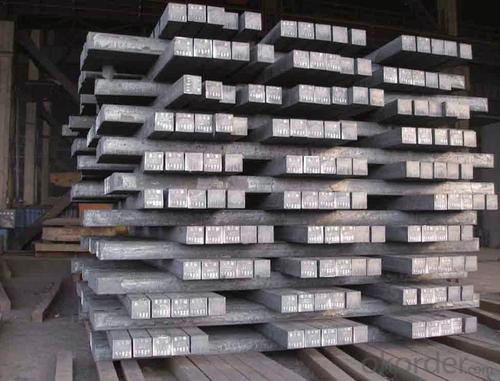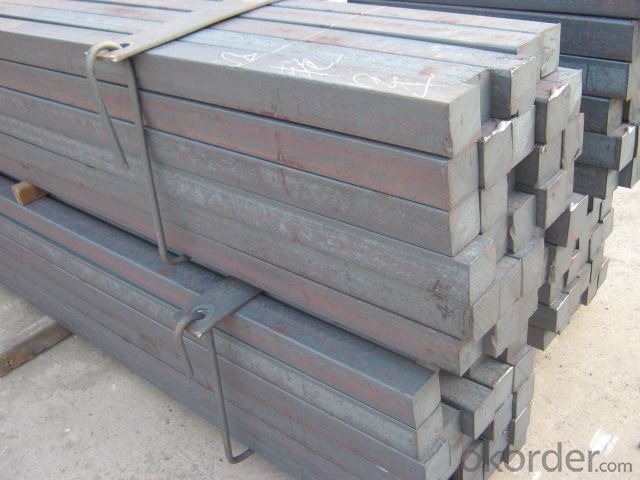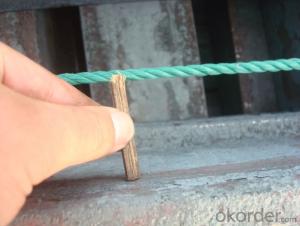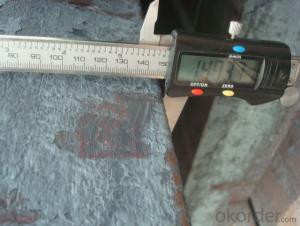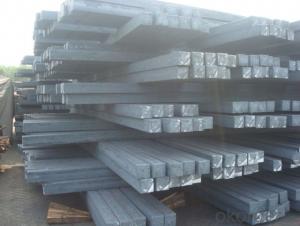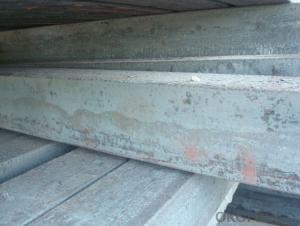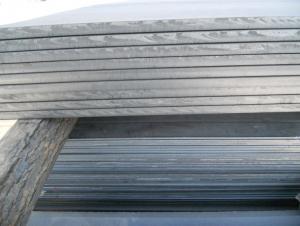Raw Material Steel Rectangle Billet Bars
- Loading Port:
- China main port
- Payment Terms:
- TT OR LC
- Min Order Qty:
- 100 m.t.
- Supply Capability:
- 100000 m.t./month
OKorder Service Pledge
OKorder Financial Service
You Might Also Like
Range of thickness: 150-240 - mm +/- 5 mm width range: 880-1530 - mm +/- 20 mm
Length: 3700-10000 - mm +/- 500 - mm
Cross-sectional size: 64 * 64; 82 * 82; 98 * 98; 124 * 124; 120 * 150; 152 * 164; 152 * 170 mm
Length: 9000 mm
Section of tolerance: billet: 1.0 +/- 2.0-1.0 +/- 1.0 mm slab: width: +/- 2.0 mm thickness: +/- 3.0 mm
The length tolerance: +/- 200 mm
Section diagonal tolerance: 3.5-8.0 MM
Billet section size protrusions requirements: < 1242 mm, do not allow; > = 1242 mm, < = 2 mm 1242 mm, < = 3 mm
Beheading (shear) extension deformation: < 1242 mm billet: no control; The slab: < = 15 mm
Surface tilt: no more than billet section 0.1
Bending: every 1 m length is not more than 10 mm.
Notes:
1, The theoretical weights in the list, base on the density of 7.85 g/cm3.
2, Formula for theoretical weight of Square bar: (length of a side)2 * 0.00785
3, The numbers with *mean that they are not regular or we don’t offer them.
-Regular length of Square Bar:
Steel | Length of a side (mm) | Length of steel (m) |
Normal steel | < 25 | 4~10 |
> 25 | 3~9 | |
Steel of high quality | All measure | 2~6 |
Tool steel >75 | 1~6 |
Usage/Applications
-The Square Bar is normally used as structure steel.
-Row material for other structure steel like steel angles, channels, I-beams, H-beams, etc…
Packaging & Delivery
-Packing Detail: The products can be packed in bundles by steel wires.
-Marks: We make tag marks and color marks. The tag marks with white background and red company logo will be tied up to each bundle of the products. The information is usually including basic information of products and company and other information requested by customers. As for color marks, we will paint both ends of bundles to make sure that it will be more convenient for customers to distinguish them from other products.
-Delivery Detail: 30~45 working days after receive buyer’s T.T. or L/C.
Transportation
-The products can be delivered by bulk vessel or by container. As for container, products with the length of 6m will be loaded in 20’ container, with 9m or 12m, in 40’ container.
-The maximum quantity of loading of container is 25 tons.
-The products are usually transported to the nearest port from the production place.
- Q: How do steel billets contribute to the overall thermal insulation of a structure?
- Steel billets do not contribute directly to the overall thermal insulation of a structure. Thermal insulation is primarily achieved through the use of materials with low thermal conductivity, such as insulation boards or panels made from materials like fiberglass, foam, or mineral wool. Steel billets, on the other hand, are typically used as a raw material in the construction industry for various applications, such as the production of steel beams, columns, and other structural components. These components, when properly integrated into a building's structure, can indirectly contribute to the overall thermal insulation of a structure. For instance, steel beams and columns can help support and distribute the load of insulation materials, ensuring they remain in place and perform their insulating function effectively. Additionally, steel components can be designed to minimize thermal bridging, which is the transfer of heat between materials with different thermal conductivities. By reducing thermal bridging, steel components can help maintain a more uniform temperature throughout the structure and prevent heat loss or gain at these junctions. However, it is important to note that the primary role of steel billets in a structure is not thermal insulation. Instead, they provide structural stability, durability, and strength to the building. To achieve optimal thermal insulation, additional materials and construction techniques specifically designed for insulation purposes should be used in conjunction with steel components.
- Q: How are steel billets distributed in the market?
- Steel billets are distributed in the market through various channels and processes. These channels can be broadly categorized into three main methods: direct sales, through distribution networks, and online platforms. Direct sales involve manufacturers or steel mills selling their billets directly to customers, such as construction companies, fabricators, or steel service centers. This method allows manufacturers to have better control over pricing, quality, and delivery schedule. It also enables them to build direct relationships with customers and understand their specific requirements. Distribution networks play a significant role in the distribution of steel billets. These networks consist of wholesalers, distributors, and stockists who purchase steel billets from manufacturers and sell them to end-users or smaller retailers. Distribution networks have extensive market reach, allowing them to cater to a wide geographical area. They provide convenience to customers by maintaining an inventory of steel billets, ensuring timely availability and reducing lead times. In recent years, online platforms have emerged as a popular method for distributing steel billets. Online trading platforms connect buyers and sellers of steel billets, providing a convenient and efficient way to conduct business transactions. These platforms allow manufacturers to reach a global customer base, while buyers can access a wide range of suppliers and compare prices and specifications. Online platforms also provide transparency and reduce the need for intermediaries, resulting in cost savings. Regardless of the distribution method, the logistics of steel billets' transportation and storage are crucial. Steel billets are typically transported in bulk using various modes of transportation, including trucks, trains, or ships. To ensure the quality and integrity of the billets, proper storage facilities are necessary, which include warehouses or yards equipped with cranes and heavy-duty machinery. Overall, the distribution of steel billets involves a complex network of manufacturers, distributors, and online platforms, all working together to meet the diverse needs of customers. This ensures a steady supply of steel billets in the market, supporting various industries such as construction, manufacturing, and infrastructure development.
- Q: Can steel billets be forged into complex shapes?
- Yes, steel billets can be forged into complex shapes using various forging techniques such as open die forging, closed die forging, or impression die forging. These processes involve heating the billet and applying pressure to shape it into the desired form.
- Q: How are steel billets forged into shape?
- The process of hot forging is utilized to shape steel billets. It entails heating the billet to a temperature that enables easy manipulation, typically ranging from 1100 to 1250 degrees Celsius. Once heated, the billet is positioned on a die, which is a specially designed tool with a cavity that imparts the desired shape onto the final product. Pressure is exerted on the billet by a large mechanical or hydraulic press, compelling it to fill the die cavity. This pressure induces the steel to flow and take the shape of the die, resulting in the intended form of the forged item. Depending on the product's size and complexity, the pressure applied during forging can reach several thousand tons. Throughout the forging process, the steel billet undergoes plastic deformation, causing its internal structure to rearrange and the metal grains to align. This grain alignment enhances the mechanical properties of the forged product, increasing its strength and durability. To achieve the final dimensions and features, additional operations such as trimming, piercing, or punching may be conducted after the initial shaping. These post-forging operations can be carried out while the steel is still hot or after it has cooled down. Once the desired shape is attained, the forged product is slowly cooled to alleviate any residual stresses and prevent cracking. This cooling process, known as annealing, enhances the metallurgical properties of the steel and improves its overall performance. To summarize, the hot forging process involves heating the steel billet, placing it on a die, applying high pressure to shape it, and subsequently cooling it to optimize its mechanical properties. This process enables the transformation of steel into various intricate shapes, making it a versatile and extensively used material across multiple industries.
- Q: How are steel billets used in the manufacturing of construction materials?
- The manufacturing of construction materials relies heavily on steel billets, which are a necessary raw material. These semi-finished forms of steel serve as the initial stage for various construction products, including rebars, beams, columns, and plates. During the production process, steel billets undergo heating and are then passed through a series of rolling mills to achieve the desired shape. For example, when producing rebars, the billet is heated and rolled into long, slim bars of different diameters. These rebars are commonly used in construction to reinforce concrete structures, ensuring their durability and strength. Likewise, steel billets are utilized in the creation of beams, columns, and plates, which are essential elements in building construction. Beams provide structural support, while columns bear the weight of the structure and transmit loads to the foundation. Plates, on the other hand, find applications in flooring, walls, and roofing. The utilization of steel billets in construction materials offers numerous benefits. Steel, renowned for its high strength-to-weight ratio, provides exceptional structural integrity, resulting in more efficient and cost-effective construction. Furthermore, steel is highly ductile, allowing it to be easily shaped and molded into various forms, enabling versatility in design and construction. Additionally, steel is a durable material that exhibits excellent resistance to environmental factors like corrosion and fire. Consequently, steel construction materials have a long lifespan and are suitable for a wide range of applications, including high-rise buildings, bridges, and infrastructure projects. In conclusion, steel billets play a vital role in the manufacturing of construction materials. By being transformed into rebars, beams, columns, and plates, these billets provide the necessary strength, durability, and versatility required in the construction industry.
- Q: What are the main factors that influence the strength of steel billets?
- The main factors that influence the strength of steel billets include the chemical composition of the steel, the heat treatment process, the presence of impurities and alloying elements, the cooling rate during the solidification process, and the mechanical processing and deformation of the billets.
- Q: How are steel billets used in the production of railway infrastructure?
- The production of railway infrastructure relies heavily on steel billets, which are crucial for creating various railway components such as rails, sleepers, and fasteners. These semi-finished steel products undergo a hot rolling process to shape them into long and narrow sections with consistent cross-sections, serving as the foundation for railway tracks. Rails, one of the primary uses of steel billets in railway infrastructure, are formed from the processed billets. These rails, available in different lengths and dimensions, provide stability and a sturdy platform for trains to run on. The strength and durability of steel ensure that the tracks can withstand heavy loads and frequent traffic. Steel billets are also used to manufacture sleepers, which act as horizontal supports for the rails. Concrete or wooden sleepers are created from the shaped and formed billets and are laid on the track bed to maintain the alignment and gauge of the tracks. Sleepers play a vital role in distributing the weight of trains and providing stability. Furthermore, steel billets are essential in producing fasteners like bolts, nuts, and clips. These fasteners secure the rails to the sleepers, ensuring that they remain in position during train operations. Steel's strength and resilience make it a reliable material for these critical components, which must withstand significant stress and vibrations. In conclusion, steel billets are indispensable in the production of railway infrastructure. Their versatility and strength make them suitable for creating rails, sleepers, and fasteners, which are vital for a reliable and robust railway system. Without steel billets, the construction and maintenance of railway tracks would be impossible, impacting the efficiency and safety of train operations.
- Q: What is the role of steel billets in the construction of bridges?
- Steel billets play a critical role in the construction of bridges. These long, rectangular bars of steel are often used as raw material to produce various structural components of a bridge. One of the primary uses of steel billets in bridge construction is for the fabrication of beams and girders. These components provide the necessary support and load-bearing capacity to ensure the bridge can withstand the weight of vehicles, pedestrians, and other loads. Steel billets are heated and then rolled into the desired shape to create these structural elements, which are subsequently welded or bolted together to form the bridge's framework. Additionally, steel billets are also used to produce reinforcement bars, commonly known as rebar. Rebar is essential in providing tensile strength to concrete structures, including bridge foundations, piers, and abutments. By reinforcing the concrete with steel billets in the form of rebar, bridges can withstand the forces caused by heavy traffic, wind, and other external factors. The use of steel billets in bridge construction offers several advantages. Firstly, steel is incredibly strong and has a high strength-to-weight ratio, making it an ideal material for bridges. Steel billets can withstand heavy loads and provide the necessary structural integrity, ensuring the longevity and durability of the bridge. Moreover, steel is highly resistant to corrosion, which is crucial for bridges exposed to harsh weather conditions and environmental factors. Corrosion can weaken the structure of a bridge, compromising its safety and longevity. However, by using steel billets, which can be coated or galvanized to enhance corrosion resistance, bridges can maintain their structural integrity over an extended period. In conclusion, steel billets play a vital role in the construction of bridges. They are used to fabricate beams, girders, and rebar, providing the necessary strength, support, and durability to withstand heavy loads and external forces. Steel billets contribute to the overall safety, longevity, and functionality of bridges, making them a critical component in bridge construction.
- Q: 20 what is the difference between manganese silicon steel billet and Q235 billet?
- 20 manganese silicon steel billet for high strength steel,Q235 billet is almost the most common steel, requiring the lowest.
- Q: What are the main factors affecting the hardenability of stainless steel billets?
- The hardenability of stainless steel billets, which refers to the material's ability to be hardened through heat treatment, can be influenced by various factors. These factors include: 1. Alloy composition: The composition of stainless steel, especially the presence of carbon, chromium, nickel, and molybdenum, plays a crucial role in determining its hardenability. Higher carbon content generally improves hardenability, while elements like chromium and nickel enhance corrosion resistance but may decrease hardenability. 2. Grain size: The grain size of stainless steel billets affects the rate and depth of hardening. Finer grain structures typically exhibit better hardenability compared to coarser ones. This is because smaller grains allow for a more even distribution of carbon and alloying elements, resulting in improved hardening response. 3. Heat treatment conditions: The specific heat treatment process utilized, including heating and cooling rates, soaking time, and quenching media, has a significant impact on the hardenability of stainless steel billets. Proper control of these parameters is essential to achieve the desired hardness and mechanical properties. 4. Cooling rate: The rate at which the billets are cooled during the quenching process is a critical factor in determining their hardenability. Rapid quenching, such as water or oil quenching, promotes martensitic transformation and leads to greater hardness. Slower cooling rates, such as air cooling, result in a softer and less hardened structure. 5. Cross-sectional thickness: The thickness of the stainless steel billets also affects their hardenability. Thicker sections tend to have lower hardenability due to slower heat transfer rates during quenching. Conversely, thinner sections can achieve higher hardness levels due to faster cooling rates. 6. Prior microstructure: The initial microstructure of the stainless steel billets, whether they are in an annealed or cold-worked state, can influence hardenability. Cold work can introduce dislocations and grain boundaries, which may impede the diffusion of carbon and alloying elements during heat treatment, leading to reduced hardenability. Considering these factors, manufacturers and engineers must carefully select stainless steel grades and tailor the heat treatment process to achieve the desired level of hardenability and mechanical properties in stainless steel billets.
Send your message to us
Raw Material Steel Rectangle Billet Bars
- Loading Port:
- China main port
- Payment Terms:
- TT OR LC
- Min Order Qty:
- 100 m.t.
- Supply Capability:
- 100000 m.t./month
OKorder Service Pledge
OKorder Financial Service
Similar products
Hot products
Hot Searches
Related keywords


